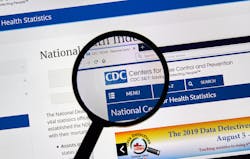CDC Names Pathogen Genomics Centers of Excellence
The Centers for Disease Control and Prevention (CDC) has announced 5-year awards to five state public health departments to establish the Pathogen Genomics Centers of Excellence (PGCoE) network.
The PGCoE network will receive approximately $90 million over the next 5 years to foster and improve innovation and technical capacity in pathogen genomics, molecular epidemiology, and bioinformatics to better prevent, control. and respond to microbial threats of public health importance.
CDC said the network represents an unprecedented opportunity to expand and deepen collaboration between U.S. public health agencies and universities to form a national resource that will advance genomic surveillance. The five centers are:
- The Georgia Department of Public Health will partner with six academic institutions: University of Georgia, Georgia Tech Research Institute, Emory University, Augusta University, Georgia State University, and the University of Texas Health Science Center at Houston.
- The Massachusetts Department of Public Health will partner with the Broad Institute of MIT and Harvard as lead academic partner. Other partners from Massachusetts and Connecticut include Boston University, Mass General Brigham hospital network, Yale University, Fathom Information Design, and Theiagen Genomics. In addition, it will serve as lead CoE for education with Harvard Medical School, the Broad Institute of MIT and Harvard, and the Massachusetts Consortium on Pathogen Readiness (MassCPR).
- The Minnesota Department of Health will have the University of Minnesota and the Mayo Clinic as primary partners
- The Virginia Division of Consolidated Laboratory Services will partner with the Virginia Department of Health, Virginia Commonwealth University, and the University of Virginia.
- The Washington State Department of Health will partner with the University of Washington, Fred Hutchinson Cancer Center, and the Washington Animal Disease Diagnostic Laboratory as well as with Public Health – Seattle & King County.
Combined, these Centers of Excellence will serve as a network to:
- Perform a landscape analysis of gaps, needs, and opportunities for genomics in the United States public health system
- Pilot and implement genomics technologies and applications for public health
- Educate and train health departments on the use of genomics
- Prepare for and respond to infectious disease threats
“The collaboration with our public health and academic partners to conduct and analyze SARS-CoV-2 genomic data has been critical to our COVID-19 response over the past couple years.” said Christopher R. Braden, M.D., Acting Director, National Center for Emerging and Zoonotic Infectious Diseases, in a statement. “Building upon that experience by establishing the Pathogen Genomics Centers of Excellence, a collaboration among state health departments and educational institutions, will help us ensure that public health is innovative, robust, and resilient in the future.”
“The Massachusetts COVID-19 response has relied on our many colleague laboratories, institutions, and organizations, including universities and partners in the medical, public health, and scientific community,” said DPH Assistant Commissioner Kevin Cranston, director of the Bureau of Infectious Disease and Laboratory Sciences, in a statement. “We believe this Center of Excellence will spur new innovation and inform how we address future public health threats.”


